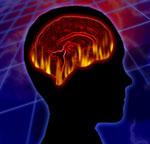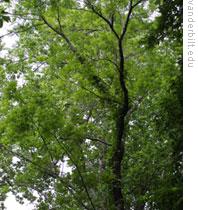-
(单词翻译:双击或拖选)
This is SCIENCE IN THE NEWS in VOA Special English. I'm Barbara Klein.
VOICE TWO:
And I'm Steve Ember. This week, we will tell about an American study of the brain disorder1 schizophrenia. We tell about cars that use hydrogen as fuel. And, we will tell how one kind of tree deals with threats to its existence.
(MUSIC)
VOICE ONE:
 People who are schizophrenic sometimes hear voices or see things that are not real. They might believe other people want to hurt them. They can become fearful and socially withdrawn2.
People who are schizophrenic sometimes hear voices or see things that are not real. They might believe other people want to hurt them. They can become fearful and socially withdrawn2. America's National Institute of Mental Health describes schizophrenia as a brain disorder that is severe and disabling. It is also chronic3, meaning long term.
The disorder usually appears in young men in their late teens or early twenties and in women in their twenties or thirties. Experts say it rarely appears in children. But when it does, it generally affects them more severely4 than adults.
VOICE TWO:
Children with schizophrenia are often treated with "second-generation" antipsychotic drugs. But do these costly5 newer drugs work better than older ones that cost less? The National Institute of Mental Health recently paid for a study by four universities in the United States. The research teams found that the answer was no.
They studied one hundred nineteen people between the ages of eight and nineteen. The patients were observed over an eight-week period. Some received two newer drugs: risperidone or olanzapine. Others received a first-generation antipsychotic drug, molindone.
VOICE ONE:
The study found that all of the patients experienced about the same improvement. But the risperidone and olanzapine caused serious weight gain. In fact, the institute cancelled the olanzapine research because the patients who took it gained an average of almost six kilograms. The concern was that the weight gain could lead to diabetes6.
(MUSIC)
VOICE TWO:
For years, the automobile7 industry has been testing vehicles that use hydrogen as fuel. Now, people across the United States have had a chance to see and even drive cars that get power from hydrogen fuel cells.
 |
| General Motors' Equinox fuel cell vehicle |
The event was called Hydrogen Road Tour Oh-Eight. It took place earlier this year in thirty-one American cities. The road tour started in Maine and ended in southern California on August twenty-third.
Nine carmakers, two federal agencies and two other groups helped organize the event. It gave people interested in new technologies a chance to possibly experience the future of transportation.
VOICE ONE:
During the tour's stop in Washington, D.C., several hundred people gathered to test drive hydrogen powered cars. The cars look like other vehicles driven by millions of Americans everyday. But it is hydrogen, not more traditional fuels, that provides power for the cars.
Today's fuel cells represent huge steps forward in technology. But the hydrogen fuel cell is not a new idea. The fuel cell was invented by Sir William Grove8 of Britain in eighteen thirty-nine. Since then, many different designs have been invented.
There is one place where fuel cells are a proven technology: in space. The American space agency used fuel cells in its Apollo spaceships in the twentieth century. And fuel cells provide all the electrical power for space shuttles.
VOICE TWO:
The most useful fuel cell for transportation purposes is the Polymer Electrolyte Membrane9, or P.E.M., fuel cell. It is simple and can operate at temperatures of sixty to eighty degrees Celsius10. That is much lower than other fuel cell designs.
A P.E.M. fuel cell has two sides separated by a thin substance or membrane. Hydrogen gas is forced through one side where it comes in contact with a reactive material containing the metal platinum11.
The membrane separates the electrons from the protons in the hydrogen atoms. The protons pass through it to the other side of the fuel cell. But the electrons are captured to do work: like powering a motor.
Oxygen from the air is forced into the other side of the fuel cell. There, the gas meets the protons that have passed through the membrane. They combine to form water and heat.
VOICE ONE:
A single fuel cell does not produce a lot of electricity. But when many fuel cells are combined, they can produce enough electricity to power a vehicle. The product of the chemical reaction that powers fuel cells is water. This makes fuel cells a very clean technology.
But fuel cell cars have been slow to develop because of many technical problems that have to be solved. For example, it is unclear how long the membranes12 in P.E.M. fuel cells will last.
Also, fuel cells need water for their chemical reactions. They must be designed to start easily in low temperatures and in dry climates. And smaller, less costly fuel cells must be designed before they can truly replace gasoline engines.
VOICE TWO:
The Hydrogen Road Tour Oh-Eight has shown the progress carmakers have made. BMW, Daimler, Ford13, General Motors and Honda took part in the event. Also included were Hyundai-Kia, Nissan, Toyota and Volkswagen. Most of these companies already have hydrogen-powered models that are in use on roads today.
There are more models of fuel cell vehicles being tested than ever before. The threat of climate change and the high cost of oil has increased interest in these vehicles that do not cause pollution. But car buyers should not expect to see fuel cell cars at their local dealer14 any time soon. Automakers say they will not build many fuel cell cars until hydrogen fueling and service stations are widely available. And that will cost billions of dollars and years of effort.
(MUSIC)
VOICE ONE:
 |
| A walnut15 tree |
Finally, American scientists have discovered that walnut trees can produce more than walnuts16. The scientists say walnut trees also can make a chemical form of the popular pain-killing medicine aspirin17. The trees do this under the stress, or pressure, of disease or other threats. Scientists say the chemical may help the trees reduce damage from dry weather, unseasonable temperatures and other changes in the environment.
VOICE TWO:
Thomas Karl reported the discovery. He works for the National Center for Atmospheric18 Research, NCAR, in Boulder19, Colorado. The National Science Foundation paid for the study. The results appeared recently in the publication Biogeosciences.
The results are important because presence of the chemical could warn growers early that a tree is in danger. Growers could recognize a problem before leaves on walnut trees die and fall off. The scientists said the findings also show that a plant can communicate with other plants through the atmosphere. For example, a tree could communicate when it is under attack from insects. With that information, a grower could begin corrective treatment.
VOICE ONE:
Researchers have known for a long time that laboratory plants may produce methyl salicylate, aspirin's chemical form. Aspirin was first produced from the bark covering on willow20 trees. But the researchers had never before found methyl salicylate in a forest. They had not confirmed that trees could emit, or release, large amounts of the chemical into the atmosphere.
The American scientists discovered the chemical by accident. It happened after the NCAR team placed special measuring equipment in an area of walnut trees near Davis, California. The equipment was placed on structures about thirty meters above ground.
VOICE TWO:
The goal of the team was to observe some chemicals called volatile21 organic compounds, or VOCs, that the trees emit. The organic compounds can influence climate and affect pollution. Mister Karl and his team were surprised to find that the emissions22 of the VOCs contained methyl salicylate.
The scientists said a long period without rain had already affected23 the trees. Then the stress increased. Leaf temperatures dropped to as low as about four and six-tenths degrees Celsius during the night. The cool conditions especially affected the trees when temperatures climbed quickly in the morning. The team said the change in temperature probably made the walnut tree react. The tree apparently24 attempted to prevent freezing by emitting the chemical form of aspirin.
(MUSIC)
VOICE ONE:
This SCIENCE IN THE NEWS was written by Mario Ritter, Jerilyn Watson and Caty Weaver25. Our producer was Brianna Blake. I'm Barbara Klein.
VOICE TWO:
And I'm Steve Ember. You can read and listen to our programs at voaspecialenglish.com. Join us next week for more news about science in VOA Special English.
 收听单词发音
收听单词发音
1
disorder

|
|
| n.紊乱,混乱;骚动,骚乱;疾病,失调 | |
参考例句: |
|
|
|
2
withdrawn

|
|
| vt.收回;使退出;vi.撤退,退出 | |
参考例句: |
|
|
|
3
chronic

|
|
| adj.(疾病)长期未愈的,慢性的;极坏的 | |
参考例句: |
|
|
|
4
severely

|
|
| adv.严格地;严厉地;非常恶劣地 | |
参考例句: |
|
|
|
5
costly

|
|
| adj.昂贵的,价值高的,豪华的 | |
参考例句: |
|
|
|
6
diabetes

|
|
| n.糖尿病 | |
参考例句: |
|
|
|
7
automobile

|
|
| n.汽车,机动车 | |
参考例句: |
|
|
|
8
grove

|
|
| n.林子,小树林,园林 | |
参考例句: |
|
|
|
9
membrane

|
|
| n.薄膜,膜皮,羊皮纸 | |
参考例句: |
|
|
|
10
Celsius

|
|
| adj.摄氏温度计的,摄氏的 | |
参考例句: |
|
|
|
11
platinum

|
|
| n.白金 | |
参考例句: |
|
|
|
12
membranes

|
|
| n.(动物或植物体内的)薄膜( membrane的名词复数 );隔膜;(可起防水、防风等作用的)膜状物 | |
参考例句: |
|
|
|
13
Ford

|
|
| n.浅滩,水浅可涉处;v.涉水,涉过 | |
参考例句: |
|
|
|
14
dealer

|
|
| n.商人,贩子 | |
参考例句: |
|
|
|
15
walnut

|
|
| n.胡桃,胡桃木,胡桃色,茶色 | |
参考例句: |
|
|
|
16
walnuts

|
|
| 胡桃(树)( walnut的名词复数 ); 胡桃木 | |
参考例句: |
|
|
|
17
aspirin

|
|
| n.阿司匹林 | |
参考例句: |
|
|
|
18
atmospheric

|
|
| adj.大气的,空气的;大气层的;大气所引起的 | |
参考例句: |
|
|
|
19
boulder

|
|
| n.巨砾;卵石,圆石 | |
参考例句: |
|
|
|
20
willow

|
|
| n.柳树 | |
参考例句: |
|
|
|
21
volatile

|
|
| adj.反复无常的,挥发性的,稍纵即逝的,脾气火爆的;n.挥发性物质 | |
参考例句: |
|
|
|
22
emissions

|
|
| 排放物( emission的名词复数 ); 散发物(尤指气体) | |
参考例句: |
|
|
|
23
affected

|
|
| adj.不自然的,假装的 | |
参考例句: |
|
|
|
24
apparently

|
|
| adv.显然地;表面上,似乎 | |
参考例句: |
|
|
|
25
weaver

|
|
| n.织布工;编织者 | |
参考例句: |
|
|
|















